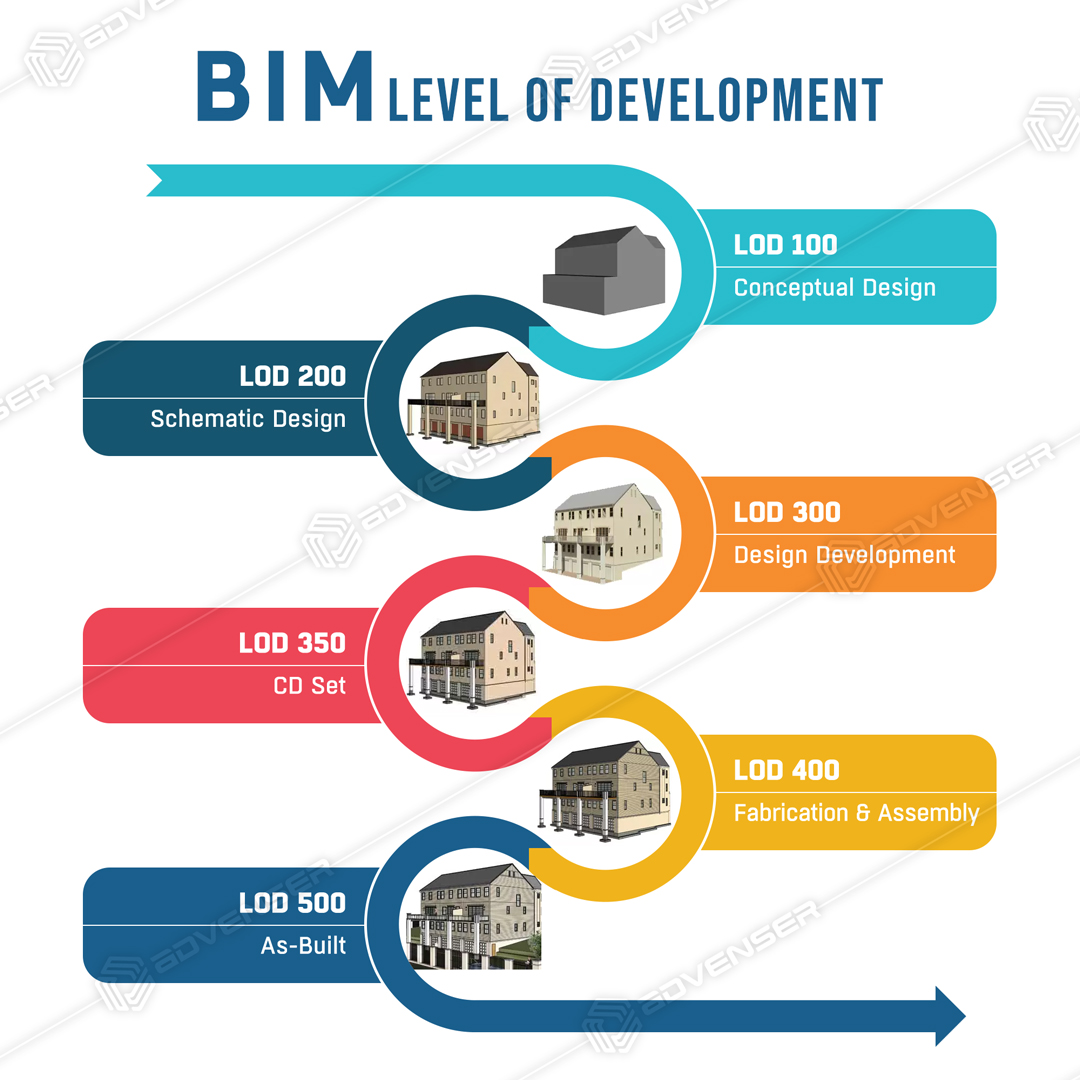Debunking Common Misconceptions About BIM Level Of Development (LOD)
Debunking Common Misconceptions About BIM LOD

Understanding BIM LOD is crucial for harnessing the full potential of BIM in construction projects. LOD defines BIM elements’ degree of detail and reliability at various project stages, ensuring that information is accurate and aligned with project objectives. However, certain misconceptions have taken root, clouding its true essence.
This blog aims to debunk these misconceptions and reveal their essential role in modern construction and design. Whether a seasoned industry professional or a beginner, this exploration seeks to reveal LOD’s true nature and dispel myths that may hinder progress toward BIM excellence. So, let’s unravel the truth about BIM LOD.
What is BIM Level of Development (LOD)?
BIM Level of Development is like the compass that guides BIM projects through the vast and complex terrain of construction and design. To truly comprehend its significance, let’s break it down.
Defining BIM LOD:
BIM LOD is a framework that measures the detail and reliability of information related to Building Information Modeling elements at different stages of a project’s lifecycle. It serves as a roadmap, indicating information’s amount, accuracy, and availability. LOD ranges from LOD 100 (basic) to LOD 500 (detailed), with each level corresponding to a specific stage in a project, ensuring that BIM elements align with the project’s evolving requirements.
LOD, often misunderstood as solely about 3D Modeling, encompasses a wide range of data beyond mere geometry, including attributes, specifications, material properties, cost data, and maintenance schedules. It goes beyond just the appearance of a building, focusing on its composition, function, and fit within the project context. This comprehensive approach to building design is essential for successful construction and maintenance.
Common Misconceptions about BIM LOD
Now that we’ve laid the groundwork for understanding BIM Level of Development (LOD), it’s time to shine a light on some common misconceptions that have cast shadows on this vital concept.
Misconception 1: LOD is a Universal Standard
One common misconception in Building Information Modeling (BIM) often suggests that Level of Development (LOD) is a uniform standard applied to all organizations and regions, regardless of unique attributes and requirements of construction and design projects.
Reality:
In reality, LOD is a dynamic concept that varies significantly between organizations, industries, and regions. Its practices, standards, and expectations differ based on factors like project complexity, goals, and local regulations. Therefore, LOD should be customized to match each project’s specific needs and objectives, ensuring a comprehensive understanding of the project.
Misconception 2: LOD is Solely 3D Modeling
One widespread misconception is that Building Information Modeling (BIM) is often misunderstood as a 3D modeling approach, overlooking its depth and versatility. Many assume it only involves visually appealing 3D representations of buildings or infrastructure projects.
Reality:
LOD is a comprehensive concept that extends beyond 3D Modeling to include attributes, data, and information for each BIM element, transforming the BIM model into a comprehensive digital twin of the physical project.
Misconception 3: Higher LOD Always Means Better Quality
A prevalent misconception in BIM is the belief that achieving the highest Level of Development (LOD) for a project implies superior quality and accuracy, overlooking the importance of balance and appropriateness in LOD application despite more detailed models.
Reality:
LOD is a versatile concept ranging from basic geometric representations to detailed models with rich attribute data. The appropriate level depends on the project’s stage, goals, and information needed. Over committing to a high LOD too early can lead to excessive complexity, cost, and wasted effort.
Misconception 4: LOD is Only for Design
One common misunderstanding about Building Information Modeling (BIM) is that the Level of Development (LOD) is only necessary during the design phase, overlooking its continued importance throughout the project’s lifecycle despite its significance once the design is complete.
Reality:
LOD is a crucial tool in the design phase, facilitating visual representation and decision-making. Its value extends throughout the project lifecycle, including construction, facility management, renovations, and retrofits. Its adaptability ensures its value extends beyond the initial design.
Misconception 5: LOD Determines Cost Estimates
A common misconception in the world of construction and design is the belief that the Level of Development (LOD) directly influences the accuracy of project cost estimates, overlooking other critical factors that influence project costs despite higher LODs being more precise.
Reality:
LOD is a crucial factor in cost estimation, primarily affecting it through the quantity takeoff process. A higher LOD provides more detailed information about building elements, making it easier to calculate quantities accurately. For instance, at LOD 400, precise measurements of walls, doors, and windows simplify material and labor cost estimation.
Misconception 6: LOD Guarantees Clash-Free Models
Another misconception in Building Information Modeling (BIM) is that a higher Level of Development (LOD) ensures a clash-free design, as it automatically identifies and resolves potential conflicts and interferences among building elements.
Reality:
LOD is crucial for clash detection and project coordination but doesn’t guarantee against clashes or interferences. It provides detailed geometry and information about BIM elements, enabling more precise clash identification. However, the absence of clashes depends on factors beyond LOD, such as design changes, human oversight, and coordination processes.
Misconception 7: LOD Replaces Project Specifications
A notable misconception in Building Information Modeling (BIM) is that a detailed model, especially at a higher Level of Development, can replace project specifications, suggesting that the BIM model can cover all necessary information and requirements, rendering project specifications obsolete.
Reality:
BIM and project specifications are complementary in construction and design projects. BIM models provide visual representations and data about building elements, while project specifications are detailed written documents outlining quality standards, materials, products, and artistry requirements. Specifications provide explicit guidance on performance, materials, and installation.
Misconception 8: LOD is Static and Cannot Be Changed
Another common misconception in Building Information Modeling (BIM) is that the Level of Development (LOD) is static and unchangeable throughout a project’s lifecycle, as it is assumed to be a fixed parameter that cannot be adjusted or adapted.
Reality:
LOD is a dynamic and flexible concept that should adapt to the project’s progress and changing requirements, ensuring that it aligns with the varying levels of detail and information required in different project phases.
Misconception 9: LOD is a Documentation Burden
The most commonly believed misconception that can hinder the effective implementation of Building Information Modeling (BIM) is the belief that maintaining a high Level of Development (LOD) is burdensome due to extensive documentation, which is often seen as administrative overhead, adding unnecessary complexity to projects.
Reality:
LOD documentation is a crucial part of the BIM process, providing clarity on the level of detail and information needed at different project stages, enhancing communication among stakeholders, and serving as a reference point for changes in LOD as the project evolves, thereby maintaining project efficiency and quality.
Misconception 10: BIM LOD is Part of an Endless Word Salad
A commonly held misconception about Building Information Modeling (BIM) often suggests that understanding BIM Level of Development (LOD) and related terms is a barrier to effective collaboration in the construction and design industry, as they are often seen as technical jargon and acronyms.
Reality:
BIM terminology, including LOD, is a structured language that facilitates efficient communication and collaboration among project stakeholders. It provides a standardized framework for describing detail and information in BIM models, enabling professionals from various disciplines to understand project requirements, goals, and expectations.
The Importance of a Comprehensive Approach to LOD
BIM LOD is not a fixed set of rules, and its inability to adapt to changing project conditions can lead to inefficiencies, inaccuracies, and missed opportunities, thus enhancing the use of Building Information Modeling (BIM) throughout the project’s lifecycle.
Check out to read the complete article: https://www.inspiringmeme.com/debunking-common-misconceptions-about-bim-level-of-development-lod/
Source: https://www.inspiringmeme.com/debunking-common-misconceptions-about-bim-level-of-development-lod/












